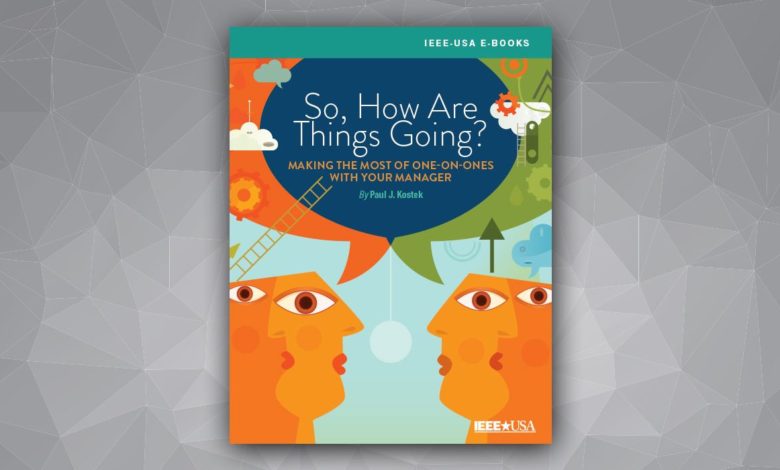
If you’ve ever had a less than satisfying one-on-one meeting with your manager, you’re not alone. Many employees think of them a futile exercise – not as a golden opportunity to increase communication and provide immediate feedback.
To help employees get more value from one-on-one meetings, longtime IEEE volunteer Paul J. Kostek has written So, How Are Things Going? Making the Most of One-on-Ones with Your Manager. IEEE-USA E-BOOKS is introducing it this month.
The idea-packed volume is full of solid, practical advice aimed at making the most of these meetings, so both employees and managers experience a win-win. The volume is available from the IEEE-USA shop for $1.99 for members and $3.99 for non-members.
“While many professionals will call such a strategy a response to the millennials – and their perceived need for constant feedback and affirmation – one-on-ones are actually a valuable meeting that all employees need,” writes Kostek. “Immediate feedback needs to be addressed sooner, rather than later. In a time when employee retention is critical to organizations, delays in responding to issues can result in loss of productivity — or even worse, losing an employee.”
The author points out that a regular, one-on-one meeting of employees and managers are a relatively recent practice in the world of work. “When I started my career, a sit-down with your manager typically only took place during the annual performance appraisal review,” he says. “Managers spent too little time, gave generic advice, and provided feedback that often was just a little too late. “Is feedback in May, on a job done poorly, of much use six months later?” he asks.
Kostek favors regular, pre-scheduled one-on-ones – bi-weekly, or at least monthly. Such meetings should typically run about 30 minutes, and are intended as a quick check-in about how a project or assignment is going. Has the employee encountered a problem or an issue that needs the manager’s help? The purpose of these discussions is also flexible. Employees can use the meeting time to discuss a training opportunity, or another project they would like to explore.
To help readers of this e-book prepare for better one-on-ones, Kostek offers myriad meeting strategies he describes in three clearly defined phases that form the core chapters of the book: Preparing, The Conversation, and Follow-up.
The first, Preparing, is obvious; almost any meeting requires advance preparation. Having an agenda is also important; if the manager doesn’t plan to have one, the employee should. Be prepared to discuss any issues, whether personal or technical. If there are any problems with work performance, the manager should bring them up. In both cases, a separate meeting should be scheduled to discuss matters such as issues or performance.
If there are no problems to discuss, the employee can use the meeting to ask a broad range of work-related questions: For example, are there any changes coming to the organization; and if so, how can he or she prepare for it? Or, perhaps there’s a training opportunity or conference that could be valuable. If so, be prepared to discuss the benefits of attending to the organization. Be sure to break out the costs, as well as the potential returns – such as new knowledge or skills to be acquired, or enhanced visibility of your organization in its industry or field.
In the second phase of a one-on-one meeting, The Conversation, the emphasis should be on how things are going. Kostek advises that because the dialogue may be difficult, being in a neutral environment can help both employee and manager feel more relaxed. The company cafeteria, a quiet meeting space, or even an offsite spot is preferable to meeting in the manager’s office.
If the manager doesn’t start the conversation with, “So, how are things going?” the employee should feel free to use the phrase. Besides talking about your work and any concerns, it’s important to try to maintain a personal tone. Topics such as vacation plans – the manager’s or yours – and any recent courses that either of you have taken, can help to set the personal connection.
Sometimes, a manager will use one-on-one sessions to raise concerns – for example, about an employee’s performance or teamwork interactions. Kostek advises listening carefully to what your manager is saying, and then repeating back what you heard before responding. Doing so will help to ensure you understand the issue, as well as give you time to shape your response.
In the final phase of one-on-ones, Follow-Up, be sure that you and your manager agree on the timing for any action items. It’s also important to use your meeting notes as a starting point for your next performance review. If you need to address some items, you can explain in the performance review what you did and how you achieved the desired outcome.
An IEEE Senior Member, Paul Kostek is a Senior Systems Engineer with Base 2 Solutions, a consulting firm in Bellevue, Washington. He has served IEEE in many leadership positions, including as 1999 IEEE-USA President, and on the IEEE Board of Directors. Kostek has also been president of the IEEE Aerospace and Electronics Systems Society, and he has chaired the American Association of Engineering Societies.
Kostek has a B.S. in electrical engineering technology from the University of Massachusetts Dartmouth, and is currently an adjunct professor in the ECE Department at Seattle University.
Helen Horwitz is an award-winning freelance writer who lives in Albuquerque, N.M. She was with IEEE from 1991 through 2011, the first nine as Staff Director, IEEE Corporate Communications.






